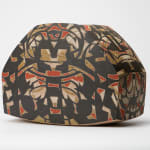Wada Morihiro 和太守卑良 1944-2008
Vessel with “One Thousand Varied Threads” Pattern,Kei-Sen-Mon-Ki 繋千文器, 1990's
Stoneware
H4 5/8 × W11 7/16 × D6 3/4 in.
H11.8 × W29.2 × D17.2 cm
H11.8 × W29.2 × D17.2 cm
With signed wood box
Sold
Further images
-
(View a larger image of thumbnail 1
)

-
(View a larger image of thumbnail 2
)

-
(View a larger image of thumbnail 3
)

-
(View a larger image of thumbnail 4
)

-
(View a larger image of thumbnail 5
)

-
(View a larger image of thumbnail 6
)

-
(View a larger image of thumbnail 7
)

-
(View a larger image of thumbnail 8
)

-
(View a larger image of thumbnail 9
)

-
(View a larger image of thumbnail 10
)

-
(View a larger image of thumbnail 11
)

-
(View a larger image of thumbnail 12
)

-
(View a larger image of thumbnail 13
)

-
(View a larger image of thumbnail 14
)

-
(View a larger image of thumbnail 15
)

-
(View a larger image of thumbnail 16
)

On his 'Sen Mon' Series, Wada Morihiro stated: 'At the time, the problem I was facing was how to create a pattern while preserving the feel of the soft clay....
On his "Sen Mon" Series, Wada Morihiro stated:
"At the time, the problem I was facing was how to create a pattern while preserving the feel of the soft clay. One of the methods I tried was to draw patterns on the surface by poking dots on the surface, apply a thin layer of white slip, and then fire it. The kiln I was using at the time was a climbing kiln burning miscellaneous wood, which contained a small amount of foreign wood, so the salt content in the wood acted on it and gave me the effect I wanted. The main motif I used was cicada. Although the motif has not yet become a definite pattern, there are signs of a tendency for the direction of the form to be guided by the pattern.
While I was visiting the house where the work was being photographed and talking with the owner and the woman in charge of editing, it occurred to me that I should use the name Sen-Mon 千文 for the style of work I was working on.
The character for "thousand," 千 which evokes the sound of semi (cicada), seemed to be a good fit for a pattern of complex interlocking lines, and I also liked the appearance of the character with a small number of strokes. In some of the articles I wrote for the special feature, I included the incident that led me to use cicada as a motif.
It is interesting to note that cicadas reappear after a gap of about 20 years, somewhat similar to the ecology of butterflies that have been lurking in the ground for many years. I think that in ancient China, cicadas were used as a sign of rebirth.
The "Sen-Mon" developed and color was added, and it became "Kei-Sen-Mon"繋千文. The meaning of the word 繋 is "connect" in Japanese. The black lines were thicker and more connected. The reason is that it was born from a Sen-Mon 千文."
"At the time, the problem I was facing was how to create a pattern while preserving the feel of the soft clay. One of the methods I tried was to draw patterns on the surface by poking dots on the surface, apply a thin layer of white slip, and then fire it. The kiln I was using at the time was a climbing kiln burning miscellaneous wood, which contained a small amount of foreign wood, so the salt content in the wood acted on it and gave me the effect I wanted. The main motif I used was cicada. Although the motif has not yet become a definite pattern, there are signs of a tendency for the direction of the form to be guided by the pattern.
While I was visiting the house where the work was being photographed and talking with the owner and the woman in charge of editing, it occurred to me that I should use the name Sen-Mon 千文 for the style of work I was working on.
The character for "thousand," 千 which evokes the sound of semi (cicada), seemed to be a good fit for a pattern of complex interlocking lines, and I also liked the appearance of the character with a small number of strokes. In some of the articles I wrote for the special feature, I included the incident that led me to use cicada as a motif.
It is interesting to note that cicadas reappear after a gap of about 20 years, somewhat similar to the ecology of butterflies that have been lurking in the ground for many years. I think that in ancient China, cicadas were used as a sign of rebirth.
The "Sen-Mon" developed and color was added, and it became "Kei-Sen-Mon"繋千文. The meaning of the word 繋 is "connect" in Japanese. The black lines were thicker and more connected. The reason is that it was born from a Sen-Mon 千文."















